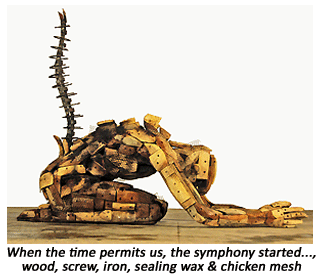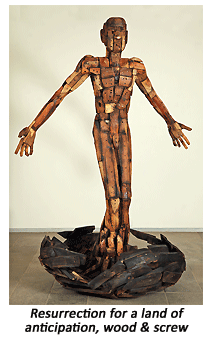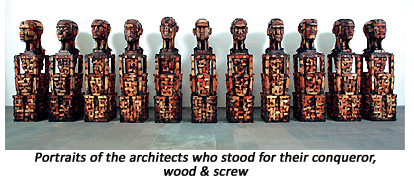- Prelude
- Editorial
- 'Public Sculptures are the Public's own Consciousness'
- Stimulating Thoughts
- Sculptural Traditions and Contemporary Art Practices
- Sculpting out a Third Dimension from Madhya Pradesh
- About Nostalgic Dragonflies and Homes in the Bags: Sculptural Snapshots from the North-East
- A Concise Chronicle of Bengal's Modern Sculpture
- Neo-sculptural Identity: Six Young Sculptors
- From Object to Experience: Notes on American Sculpture
- In the Domain of Drama Sculptures of S.Nandagopal
- Satish Gujral : Sculpting the Inner Form
- Transformation of Articulations: Mrinalini Mukherjee
- The Experiential Quotient in the Sculptures of Ravinder Reddy
- Shresta Rit Premnath A Passion for Structure
- The Anatomy of Melancholy: Sculptures of Rajesh P Subramanium
- A Crusader of/for Site Specific Public Art: Subodh Kerkar
- Installation Practices in and around Santiniketan
- A Wall is a Screen: A Promenade Film Street Performance
- Jaeger-LeCoultre An Overview
- Regency Style: Regency Furniture
- Designing the Streetscapes: Visual Elements of Pedestrian Corridors
- Sculpture Rules It All
- The Triumph of the Eternal
- Artist Index and Statistics- Anish Kapoor
- Auction Reports
- Musings from Chennai
- Art Bengaluru
- Art Events Kolkata: October-November 2010
- Mumbai Art Sighting
- An Evening of Interaction
- 6th Asian Museum Curators' Conference
- Swedish Art in India
- Couple of Difference : Recent sculptures of Karl Antao
- Previews
- In the News
- Sotheby's : Important Watches Geneva
ART news & views
The Anatomy of Melancholy: Sculptures of Rajesh P Subramanium
Volume: 3 Issue No: 11 Month: 12 Year: 2010
by Rollie Mukherjee
It is interesting to see that despite a growing preference for new media art particularly for installations, performances and video art, there is a return to conventional forms of art making. Though there are a few artists involved with the traditional mediums, their continuance does provide fresher approaches even today. It's also interesting to see how these traditional modes of art-making engage with the new aesthetic demands by working in ways where the practice doesn't look obsolete and yet connects to the contemporary. One can see an overlapping of modernist and contemporary approaches in the handling of the medium/themes creating a peculiar concoction.
performances and video art, there is a return to conventional forms of art making. Though there are a few artists involved with the traditional mediums, their continuance does provide fresher approaches even today. It's also interesting to see how these traditional modes of art-making engage with the new aesthetic demands by working in ways where the practice doesn't look obsolete and yet connects to the contemporary. One can see an overlapping of modernist and contemporary approaches in the handling of the medium/themes creating a peculiar concoction.
Sculpture, generally includes two different practices carving and modeling. One works from the outside to the inside of resistant materials and the other is a process (modeling) in which material is added from inside to the outside, respectively.
 Rajesh.P. Subramanium works in wood but he reverses the general process. By joining and pasting pieces of wood he makes his process additive rather than subtractive. Here one can find a resemblance with architectural constructions. He follows the architectural model where the basic design is geometrical and calculated and the exterior performs a formal function. The contemporary (glass/translucent) architecture opens up for viewing the spectacle inside these unapproachable/elite spaces, always luring us to desire those positions and spaces. The advancement in science which enabled the eye to turn inwards and scan through the human body also would be a relevant reference here. His sculptures resemble architectural forms yet they reveal the inside unlike the modernist architecture which hides its very process. This gives his sculptures a crudeness and also a coordination between the inside and the outside.
Rajesh.P. Subramanium works in wood but he reverses the general process. By joining and pasting pieces of wood he makes his process additive rather than subtractive. Here one can find a resemblance with architectural constructions. He follows the architectural model where the basic design is geometrical and calculated and the exterior performs a formal function. The contemporary (glass/translucent) architecture opens up for viewing the spectacle inside these unapproachable/elite spaces, always luring us to desire those positions and spaces. The advancement in science which enabled the eye to turn inwards and scan through the human body also would be a relevant reference here. His sculptures resemble architectural forms yet they reveal the inside unlike the modernist architecture which hides its very process. This gives his sculptures a crudeness and also a coordination between the inside and the outside.
His sculptures reveal the inside of the human body through vents and openings of the constructed body. But the inside tells more about pain and suffering not just of the body but also refers to the bigger world - the society. His works follow a geometrically calculated internal structure similar to the armature of any sculpture. The exterior is then added up by screwing and gluing up pieces of wood on to the armature. The pieces of wood acquire a definition only in relation to the part which is placed. They look like any other piece in the sculpture but for a few minor changes. They don't follow the logic of human anatomy but follow the convenience of the structure. The further additions and pieces define themselves in accordance with the surrounding piece. Every piece gains its positional meaning only in accordance with the other pieces in the sculpture. In a way his sculptures define the very process of their making/coming into being. This however makes many of his sculptures look alike varying only in the differing themes and issues he is dealing with. Though his subject talks about deep physical and mental pain of the body/mind, his construction technique is not expressionistic or emotionally charged.  Rather it is more mathematical and calculated. These are formed not with a process of immediacy but rather by premeditation. He joins small pieces of wood with nails and sometimes with rusty iron nets to cover the face or the vocal chord. This enhances a choked expression in his work. His sculptures are bodies conceived as construction sites.
Rather it is more mathematical and calculated. These are formed not with a process of immediacy but rather by premeditation. He joins small pieces of wood with nails and sometimes with rusty iron nets to cover the face or the vocal chord. This enhances a choked expression in his work. His sculptures are bodies conceived as construction sites.
He refers to Biblical themes and stories about resurrection and also Christian postures to depict pain and agony. His bodies talk about the human frailty to conquer pain and death, our fragility and vulnerability. One can thus see a strong sense of surrender. We can also read the humanistic impulse in many of his sculptures which bring the discourse of modernist tradition to the fore referring to Christian origins. The centrality of the human being and the longing for a redemptive savior affirms his modernist beliefs. Though his technique refers to an alienated and fragmented being, they perform an organic function rather than playing relatively localized and contextual roles.